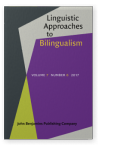Commentary
Bridging the gap between selective and non-selective L1 attrition
The role of L1-L2 structural (dis)similarity
References (15)
References
Flores-Ferrán, N. (2004). Spanish subject personal pronoun use in New York City Puerto Ricans: Can we rest the case for English contact? Language Variation and Change, 161, 49–73. 

Hicks, G., & Doínguez, L. (2017). A generative model for L1 grammatical attrition. Poster presented at GASLA 14. Southampton, April 2017.
Lardiere, D. (2009). Some thoughts on a contrastive analysis of features in second language acquisition. Second Language Research, 25(2), 173–227. 

Lipski, J. M. (1996). Patterns of pronominal evolution in Cuban-American bilinguals. In A. Roca & J. B. Jensen (Eds.), Spanish in contact: Issues in bilingualism (pp. 159–86). Somerville, MA: Cascadilla.
Otheguy, R., Zentella, A. C., & Livert, D. (2007). Language and dialect contact in Spanish in New York: Towards the formation of a speech community. Language, 831, 1–33.
Sanoudaki, E., & Thierry, G. (2015). Language non-selective syntactic activation in early bilinguals: the effect of verbal fluency. International Journal of Bilingual Education and Bilingualism, 18(5), 548–560. 

Satterfield, T. (2003). Economy of interpretation: Patterns of pronoun selection in transitional bilinguals. In V. Cook (Ed.). Effects of the Second Language on the First (pp. 214–233). Clevedon: Multilingual Matters. 

Shin, N. L. & Otheguy, R. (2009). Shifting sensitivity to continuity of reference: Subject pronoun use in Spanish in New York City. In M. Lacorte, & J. Leeman (Eds.), Español en Estados Unidos yen otros contextos: Cuestiones sociolingüísticas, políticas y pedagógicas (pp. 111–136). Madrid: Iberoamericana.
Shin, N. L., & R. Otheguy. (2005). Contact induced change? Overt nonspecific ellos in Spanish in New York. In L. Sayahi & M. Westmoreland (Eds). Selected proceedings of the 2nd Workshop on Spanish Sociolinguistics (pp. 67–75). Somerville, MA: Cascadilla.
Silva-Corvalán, C. (1994). Language contact and change: Spanish in Los Angeles. Oxford: Oxford University Press.
